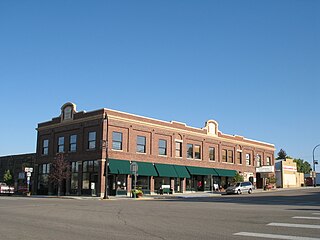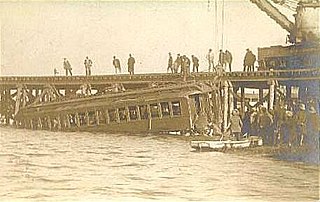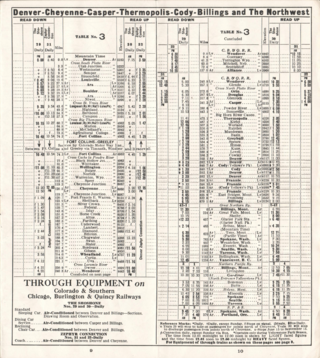
Glenrock is a town in Converse County, Wyoming, United States. The population was 2,420 at the 2020 census.

The City of Denver was a streamlined passenger train operated by the Union Pacific Railroad between Chicago, Illinois, and Denver, Colorado. It operated between 1936 and 1971. From 1936–1955 the Chicago and North Western Railway handled the train east of Omaha, Nebraska; the Chicago, Milwaukee, St. Paul and Pacific Railroad handled it thereafter. The train was the fastest long-distance train in the United States when it debuted in 1936, covering 1,048 miles (1,687 km) in 16 hours. For almost its entire career its principal competitor was the Chicago, Burlington and Quincy Railroad's Denver Zephyr. When Amtrak assumed operation of most intercity trains in the United States in 1971, it discontinued the City of Denver, preferring to use the Burlington's route between Chicago and Denver.

United Air Lines Flight 409 was a scheduled flight which originated in New York City, New York. The final flight destination was San Francisco, California, with stops in Chicago, Denver and Salt Lake City. The aircraft operating the service, a Douglas DC-4 propliner, registration N30062, crashed into Medicine Bow Peak, near Laramie, Wyoming, on October 6, 1955, killing all 66 people on board. The victims included five female members of the Mormon Tabernacle Choir and military personnel. At the time, this was the deadliest airline crash in the history of American commercial aviation. Another 66 lives had been lost earlier that year in the March 22 crash in Hawaii of a United States Navy Douglas R6D-1 Liftmaster military transport aircraft, and 66 had also died in the mid-air collision of two United States Air Force C-119G Flying Boxcars over West Germany on August 11, placing the three crashes in a three-way tie as the deadliest aviation incidents in 1955.

The Denver Zephyr was a streamlined passenger train operated by the Chicago, Burlington and Quincy Railroad between Chicago, Illinois, and Denver, Colorado. In peak years it ran to Colorado Springs. It operated from 1936 to 1973. The Denver Zephyr continued operating after the Burlington Northern Railroad merger in 1970. BN conveyed the train to Amtrak in 1971; Amtrak merged it with the Denver–Oakland City of San Francisco to form the San Francisco Zephyr and dropped the "Denver" name in 1973.

The City of San Francisco was a streamlined through passenger train which ran from 1936 to 1971 on the Overland Route between Chicago, Illinois and Oakland, California, with a ferry connection on to San Francisco. It was owned and operated jointly by the Chicago and North Western Railway (1936–55), Chicago, Milwaukee, St. Paul and Pacific Railroad (1955–71), the Union Pacific Railroad, and the Southern Pacific Railroad. It provided premium extra fare service from Chicago to San Francisco when introduced in 1936 with a running time of 39 hours and 45 minutes each way.
The Valigonda rail disaster occurred on 29 October 2005 near the town of Valigonda, south of Hyderabad in the Indian state of Telangana. A flash flood swept away a small rail bridge, and a "Delta Fast Passenger" train traveling on it derailed at the broken section of the line, killing at least 114 people and injuring over 200.

The Chunky Creek Train Wreck occurred on February 19, 1863, when a train crashed into the creek from a bridge damaged by heavy rain on the Southern Rail Road line between Meridian and Vicksburg, Mississippi.

A washaway is a particular kind of landslide that can affect man-made structures such as cuttings, embankments and bridges. They are thus a hazard to railways and road traffic.
The Eden train wreck of August 7, 1904, occurred when the No. 11 Missouri Pacific Flyer from Denver, Colorado, to St Louis, Missouri, crossed the Dry Creek arroyo bridge near Eden Station, 8 miles (13 km) north of Pueblo, Colorado. As the engine crossed the bridge, a flash flood wave passed over the trestle shearing off the front half of the train and dragging 88 people to their deaths with 22 missing and another dying later of injuries.
The Connellsville train wreck was a rail accident that occurred on December 23, 1903, on the Baltimore and Ohio Railroad near Connellsville, Pennsylvania. The Duquesne Limited, a passenger train, derailed when it struck a load of timber lying on the tracks. The timber had fallen from a freight train minutes before the collision. The crash resulted in 64 deaths and 68 injuries.

The 1906 Atlantic City train wreck occurred in Atlantic City, New Jersey, on Sunday October 28, 1906, when a West Jersey and Seashore Railroad electric train fell off a draw (swing) bridge, drowning 53 people.
The Custer Creek train wreck is the worst rail disaster in Montana history. It occurred on June 19, 1938 when a bridge, its foundations washed away by a flash flood, collapsed beneath Milwaukee Road's Olympian as it crossed Custer Creek, near Saugus, Montana, south-west of Terry, killing at least 47 people.
The Indianola Train Wreck was a railway accident that occurred at 7:08 a.m. on May 29, 1911, on the Chicago, Burlington and Quincy Railroad one half mile west of Indianola, Nebraska leaving 18 dead and 32 injured.
The Rapid City, Black Hills and Western Railroad, also known simply as the Black Hills and Western Railroad and commonly referred to as the Rapid Canyon Line or the Crouch Line, is a defunct standard gauge freight railroad line that operated in the Black Hills in the U.S. state of South Dakota. The railroad became known throughout the area for its crookedness and later became a tourist attraction. It ran from Rapid City to Mystic for a distance of 36.043 miles. The railroad ceased operations in 1947.

The Shoshone was a named passenger train of the Chicago, Burlington and Quincy Railroad and its subsidiary the Colorado and Southern Railway. The train operated between Denver, Colorado and Billings, Montana via Casper, Wyoming and the Wind River Canyon. The train operated until September 1, 1967. In 1946 the train featured standard heavyweight sleeping car accommodation, dining car service, and reclining chair cars. By 1967 the name was dropped and the train consisted of only a modernized heavyweight coach and storage mail cars which were picked up and dropped off en route.

The railway accident on the Bostian Bridge killed 23 people on August 27, 1891, west of Statesville, North Carolina, when a Richmond & Danville Railroad train derailed.

On the night of Wednesday, June 21, 1905, the New York Central Railroad's flagship passenger train, the 20th Century Limited, derailed in Mentor, Ohio, on the Lake Shore and Michigan Southern Railway line, killing 21 passengers and injuring more than 25 others on board. A switch from the mainline to a freight siding was open, causing the Limited to leave the mainline and overrun the siding at high speed. The cause of the accident was never officially determined, but overwhelming evidence points to an act of rail sabotage. The 20th Century Limited connected New York City to Chicago; its running time had just weeks earlier been reduced from 20 hours to 18.











